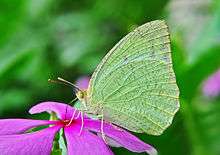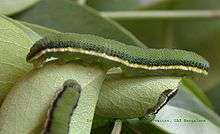Catopsilia pyranthe
| Mottled emigrant | |
|---|---|
 | |
| Male from West Bengal, India | |
| Scientific classification | |
| Kingdom: | Animalia |
| Phylum: | Arthropoda |
| Class: | Insecta |
| Order: | Lepidoptera |
| Family: | Pieridae |
| Genus: | Catopsilia |
| Species: | C. pyranthe |
| Binomial name | |
| Catopsilia pyranthe (Linnaeus, 1758) | |
Catopsilia pyranthe, the mottled emigrant, is a medium-sized butterfly of the family Pieridae found in South Asia, Southeast Asia, and parts of Australia.
Description
Male
-_Male_in_Hyderabad%2C_AP_W_IMG_7139.jpg)
The upperside is chalky white, slightly tinted in some specimens with green. The forewing is with or without a discocellular black spot, that varies in size; costa and termen sometimes without a black margin; occasionally the costa has its apical third narrowly black, broadened slightly at the apex with black spots between the anterior veins; or again, the costa may be narrowly black, the apex very broadly so, and this colour continued down the termen but narrowed posteriorly. The hindwing is sometimes immaculate, but generally with narrow terminal black spots at the apices of the veins, these often reduced to mere dots, or again so broadened as to coalesce into a narrow terminal black margin.
The underside's ground colour is similar, suffused on the anterior half of the forewing and over the whole surface of the hindwing with a greenish tint that varies to an ochraceous yellow, and, except in the very palest specimens, is evenly irrorated (sprinkled) over the greenish or ochraceous-tinted areas with transverse, short, reddish-brown strigae; both forewings and hindwings with generally an obscure discocellular reddish-brown spot or indication thereof.
_mating_in_Hyderabad%2C_AP_W_IMG_9444.jpg)
Female

The upperside is as in the male, but sometimes with a suffusion of pale greenish yellow on the terminal third or fourth only of both forewings and hindwings, rarely of that tint throughout. The forewing is always with a discocellular black spot that varies very much in size; costa sometimes narrowly black with the basal half pinkish, in other specimens narrowly black throughout, the black broadened at the apex and continued along the anterior half of the termen in a series of inwardly-pointed black spots; or again, the costa may be more broadly black, that colour widened considerably at the apex and continued broadly down the termen to vein 3, then suddenly narrowed to a slender line at the tornus. In most specimens there is an anterior postdiscal short black macular baud; in the dark forms this coalesce with the black on apex and termen. The hindwing is sometimes immaculate, sometimes with a series of terminal spots at the apices of the veins, sometimes with a narrow dusky-black terminal band broadest near the apex, narrowed posteriorly to a slender line at the tornus. In the very dark specimens there is in addition an ill-defined, short anterior postdiscal macular black band.
The underside is as in the male, with similar variations, but in addition in most specimens the discocellular spots are well defined with an outer red ring that encircles a silvery spot; on the hindwing one or two similar spots on each side of the discocellulars; generally also both wings are crossed by a transverse postdiscal line of minute red spots, which on the forewing is confined to the anterior portion, on the hindwing is nearly complete. In both sexes: antennae reddish, head and thorax anteriorly brown, thorax clothed posteriorly with long white hairs, abdomen white: beneath: the palpi, thorax, and abdomen white.[1]
Life history

The host plants of the species include Cassia species (e.g., C. fistula; C. javanica[2] or C. roxburghii;[3] C. bakeriana), Gnidia glauca,[4] Senna species (e.g. S. alata; S. auriculata; S. garrettiana), Crotalaria species, Ormocarpum cochinchinense, Sesbania species and Colocasia.[5]

The development period from egg to adult is 22 to 29 days allowing up to 11-12 generations a year.[6]
Larva: "Long, somewhat depressed, rough, green, with a white lateral line and above it a black line more or less conspicuous, formed by minute black shining tubercles. In short, this larva in very like a big specimen of a Eurema hecabe".[1]
Pupa: "Much stouter (i.e. than that of Eurema hecabe, and the keel formed by the wing-cases much less pronounced. The normal colour is pale green with a yellow lateral line. We have never found it on any plant except Senna occidentalis. It habitually rests on the upperside along the midrib, like almost all Pierine larvae." Davidson and Aitken, quoted in Bingham.[1]
Range
India, Myanmar, Bangladesh, Malaya and New Guinea.
Gallery
- Eggs on Senna occidentalis
- Caterpillar
- Pupa
- Adult
See also
References and notes
- Shihan, T.R. (2016). A Photographic Guide to the Butterflies of Bangladesh. Butterfly Reintroduction Farm, Chuadanga, Bangladesh, 165pp.
| Wikimedia Commons has media related to Catopsilia pyranthe. |
- 1 2 3 Bingham, C.T. (1907). The Fauna of British India, Including Ceylon and Burma. II (1st ed.). London: Taylor and Francis, Ltd.
- ↑ = C. javanica L.
- ↑ = C. javanica sensu Bojer
- ↑ Kunte, K. (2006). Additions to known larval host plants of Indian butterflies. Journal of the Bombay Natural History Society 103(1):119-120
- ↑ Gaden S. Robinson, Phillip R. Ackery, Ian J. Kitching, George W. Beccaloni, and Luis M. Hernández. HOSTS - a Database of the World's Lepidopteran Hostplants Accessed September 2006.
- ↑ Atluri, J. B.; S. P. Venkata Ramana; and C. Subba Reddi (2004). Ecobiology of the tropical pierid butterfly Catopsilia pyranthe. Current Science 86(3).